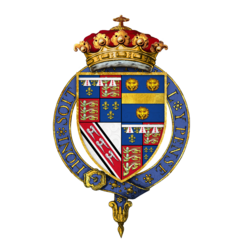Edmund de la Pole, 3rd Duke of Suffolk
| Edmund de la Pole | |
|---|---|
| Duke/Earl of Suffolk | |

Arms of Sir Edmund de la Pole,
3rd Duke of Suffolk, KG |
|
| Yorkist heir to the Kingdom of England | |
| Tenure | 16 June 1487 – 30 April 1513 |
| Predecessor | John de la Pole, Earl of Lincoln |
| Successor | Richard de la Pole |
| Spouse(s) | Margaret Scrope |
| Noble family | York |
| Father | John de la Pole, 2nd Duke of Suffolk |
| Mother | Elizabeth of York, Duchess of Suffolk |
| Born | 1471 England |
| Died | 30 April 1513 (aged 41–42) |
Edmund de la Pole, 3rd Duke of Suffolk, 6th Earl of Suffolk, KG (1471/1472 – 30 April 1513), Duke of Suffolk, was a son of John de la Pole, 2nd Duke of Suffolk and his wife Elizabeth of York.
His mother was the second surviving daughter of Richard Plantagenet, 3rd Duke of York, and Cecily Neville. She was also a younger sister to Edward IV of England and Edmund, Earl of Rutland, as well as an older sister to Margaret of York, George Plantagenet, 1st Duke of Clarence, and Richard III of England.
His paternal grandparents were William de la Pole, 1st Duke of Suffolk, and Alice Chaucer. Suffolk was an important English soldier and commander in the Hundred Years' War, and later Lord Chamberlain of England. Alice Chaucer was a daughter of Thomas Chaucer, Speaker of the Commons on three occasions, Chief Butler of England for almost thirty years, and granddaughter of the poet Geoffrey Chaucer.
De la Pole's eldest brother John de la Pole, Earl of Lincoln (c. 1464-1487), was the designated heir of his maternal uncle, Richard III of England, who gave him a pension and the reversion of the estates of Lady Margaret Beaufort. However, on the accession of Henry VII following the Battle of Bosworth Field, Lincoln took the oath of allegiance instead of claiming the throne for himself. In 1487, Lincoln joined the rebellion of Lambert Simnel and was killed at the Battle of Stoke.
...
Wikipedia
